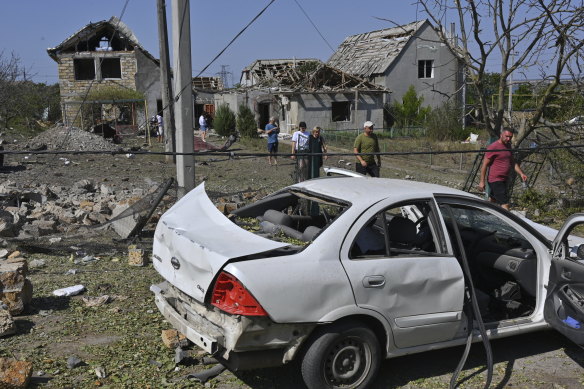
“Like most previous Russian strikes, this one was just as vile, targeting critical civilian infrastructure,” Zelensky said, adding that most of the country was targeted – from the Kharkiv region and Kyiv to Odesa and the west.
Power cuts and water supply outages were reported in many areas, including parts of Kyiv, as officials said the attack – 2½ years into the war – targeted power or other critical infrastructure across the country.
Russia stepped up its strikes on the Ukrainian power grid in March in what Kyiv has said looked like a concerted effort to degrade the system ahead of next winter, when people need electricity and heating most.
The air force downed 102 out of 127 incoming missiles and 99 out of 109 drones, Air Force Commander Mykola Oleshchuk said on Telegram, describing the attack from the air, ground and sea as “the most massive” of the war.
According to Prime Minister Denys Shmyhal, 15 regions sustained damage. Zelensky said there was “a lot of damage in the energy sector”.
Russia’s Defence Ministry said its forces used high-precision weapons on Monday to strike important energy infrastructure in Ukraine which it said supported the military-industrial complex. It listed power substations, gas compressor stations and storage sites for aircraft weapons.
The missile and drone salvo came as Ukraine claims new ground in a major cross-border incursion into Russia’s western Kursk region, while Russian forces steadily inch forward in Ukraine’s east, closing in on the transport hub of Pokrovsk.
After meeting top officials, Zelensky said a decision had been taken to “further strengthen” the Pokrovsk front, which saw at least 38 combat clashes on Monday, according to the military.
NATO member Poland said a search was under way after an “object” entered its airspace and possibly landed on Polish territory.
“Most likely it was a drone, and we assume so, because the trajectory of the flight and the speed indicate that it was definitely not a missile,” Jacek Goryszewski, spokesperson for the Polish army’s operational command, told Reuters.

People walk in front of their damaged houses after a Russian rocket attack in Usatove village, near Odesa.Credit: AP
Two Russian drones crossed the border into Belarus, Ukraine’s air force commander said.
Top Kyiv officials again urged their allies and arms suppliers to allow long-range strikes into Russia.
Zelensky also redoubled his call for allies to join the country in shooting down missiles and drones over Ukrainian airspace.
Ukraine had no powerful long-range weapons at the start of the invasion, but has since developed many models of long-range attack drone and used them to hit targets deep inside Russia, ranging from oil refineries to military airfields.
Over the weekend, Zelensky said Ukraine had developed a new “drone missile” that had been used to attack Russia and was more powerful and faster than other hardware in Kyiv’s arsenal.
Damaged facilities
At least 47 people were injured, including four children, emergency services said.
Loading
The regions that reported strikes on power or critical infrastructure included Volyn and Rivne in the north-west, Khmelnytskyi, Lviv and Ivano-Frankivsk in the west, Zhytomyr in the north, Dnipropetrovsk, Kirovohrad and Vinnytsia in central Ukraine, Zaporizhzhia in the southeast and Odesa in the south.
Zelensky said some civilian facilities were attacked with cluster munitions.
Neighbouring Moldova, whose grid is linked to that of Ukraine, reported small disruptions to its power network.
Ukraine’s Foreign Ministry official said a hydropower plant in the Kyiv region had been targeted. A video posted on social media and verified by Reuters showed a damaged dam and a fire after an apparent strike at a plant. A separate clip, also verified, showed a missile hitting a water reservoir.
In the north-eastern Sumy region, from where Ukraine launched its incursion into Russia on August 6, authorities said a railway infrastructure facility had been struck, but did not say which one or give further details.
A 69-year-old man in the Dnipropetrovsk region and a farmer in the Zaporizhzhia region were among at least seven people confirmed dead, local officials said. The others were in the regions of Kharkiv, Zhytomyr and Volyn.
Reuters, AP
Get a note directly from our foreign correspondents on what’s making headlines around the world. Sign up for the weekly What in the World newsletter here.



























